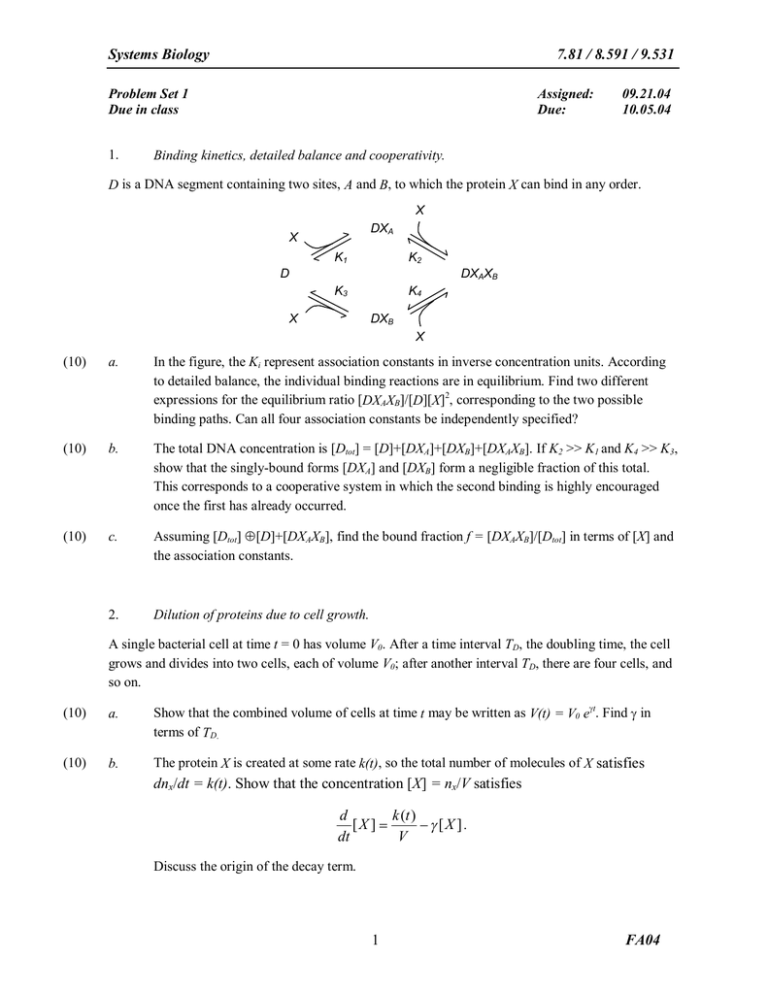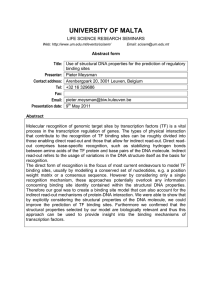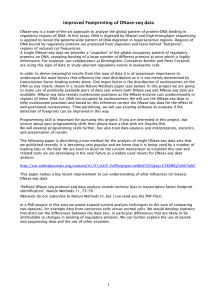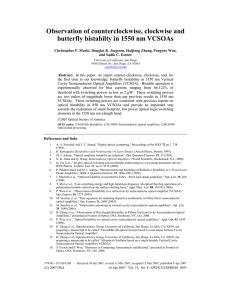Systems Biology 7.81 / 8.591 / 9.531
advertisement

Systems Biology 7.81 / 8.591 / 9.531 Problem Set 1 Due in class 1. Assigned: Due: 09.21.04 10.05.04 Binding kinetics, detailed balance and cooperativity. D is a DNA segment containing two sites, A and B, to which the protein X can bind in any order. X DXA X K1 K2 K3 K4 D DXAXB X DXB X (10) a. In the figure, the Ki represent association constants in inverse concentration units. According to detailed balance, the individual binding reactions are in equilibrium. Find two different expressions for the equilibrium ratio [DXAXB]/[D][X]2, corresponding to the two possible binding paths. Can all four association constants be independently specified? (10) b. The total DNA concentration is [Dtot] = [D]+[DXA]+[DXB]+[DXAXB]. If K2 >> K1 and K4 >> K3, show that the singly-bound forms [DXA] and [DXB] form a negligible fraction of this total. This corresponds to a cooperative system in which the second binding is highly encouraged once the first has already occurred. (10) c. Assuming [Dtot] ≈ [D]+[DXAXB], find the bound fraction f = [DXAXB]/[Dtot] in terms of [X] and the association constants. 2. Dilution of proteins due to cell growth. A single bacterial cell at time t = 0 has volume V0. After a time interval TD, the doubling time, the cell grows and divides into two cells, each of volume V0; after another interval TD, there are four cells, and so on. (10) a. Show that the combined volume of cells at time t may be written as V(t) = V0 eγt. Find γ in terms of TD. (10) b. The protein X is created at some rate k(t), so the total number of molecules of X satisfies dnx/dt = k(t). Show that the concentration [X] = nx/V satisfies d k (t ) [X ] = − γ[X ]. dt V Discuss the origin of the decay term. 1 FA04 Systems Biology 3. 7.81 / 8.591 / 9.531 Positive feedback and bistability Suppose the protein X be a transcriptional activator, and D a promoter which is activated by the binding of X. If the downstream gene happens to code for X itself, the resulting positive feedback can lead to bistability. X X v1 v0 DXAXB (10) a. D Let v1 be the rate of expression from bound DNA (DXAXB), and v0 < v1 the rate of expression from free DNA (D). Use the results of Problems 1 and 2 to show that the time-evolution of the concentration x ≡ [X] may be written in the following form: dx v0 + v1 K 1 K 2 x 2 = −γ ⋅ x 1 + K1 K 2 x 2 dt f(x) (30) b. Steady state solutions occur at those values of x for which the rates of generation ( f(x) ) and degradation ( g(x) ) are equal. Set γ = 1 and K1K2 = 1, and use the accompanying MATLAB file ps1.m to explore the intersections of f(x) and g(x) as the parameters v0 and v1 are varied. The figures (i) through (v) show schematically the types of behaviors that can occur. Plot an example each of types (i), (iii) and (v), indicating the parameter values that generated them. Label those values of x for which f(x) > g(x) with a rightward arrow, and those for which f(x) < g(x) with a leftward arrow. Which solutions are stable? • • • • (i) (10) c. g(x) • (ii) • • • • (iii) (iv) (v) The boundary between bistability and monostability is given by parameters for which the system has precisely two fixed points (types (ii) and (iv)). Setting γ = 1 and K1K2 = 1, rewrite the condition f(x) = g(x) as a cubic equation of the form x3 + c2 x2 + c1 x + c0 = 0. Any cubic can always be factorised as (x - a1)(x - a2)(x - a3). What are the conditions on the roots that would lead to type (ii) or type (iv) behavior? Apply this condition and compare coefficients to obtain parametrized equations for v1 and v0. Show on a graph of v1 vs. v0 the region over which the system is bistable. 2 FA04







